Method Article
향상된 Biosafety에 대한 고분자 - complexed Ecotropic Lentivirus과 인간의 세포의 형질 도입
요약
Lentiviruses는 유전자 기능을 탐험을위한 가치있는 연구 도구되지만, 연구진은 알려진 pantropic lentivirus 인코딩이나 의심 oncogenes의 생산을 방지하실 수 있습니다. 대안으로, 우리는 ecotropic 수용체 mSlc7a1을 표현하는 수정된 인간의 세포에 ecotropic lentivirus의 사용을 위해 안전한 프로토콜을 제시한다.
초록
줄기 세포 및 종양 생물학 연구는 종종 실험실 직원에 대한 주요 안전 문제를 제기, 알려진 또는 의심되는 oncogenes와 인간 세포의 바이러스 전달을 필요로합니다. 등 일반적으로 사용되는 VSV - G pseudotype로 Pantropic lentiviruses는, 그들이 아닌 나누어 세포를 포함하여 많은 세포 유형을 transduce 수 있기 때문에 유전자 기능을 연구를위한 유용한 도구입니다. 그러나, 연구자들은 높은 biosafety 수준의 처리 요구 사항 및 안전 문제로 인해 oncogenes을 인코딩 pantropic 바이러스의 생산과 원심 분리를 방지하실 수 있습니다. C - Myc 및 SV40 큰 T 항원을 포함한 여러 적정량 oncogenes은, 유도 pluripotent 줄기 세포 (iPSC)의 생산을 강화하는 것으로 알려져 있습니다. 다른 모든 알려진 iPSC - 유도 유전자 변화 (OCT4, SOX2, KLF4, NANOG, LIN28, 그리고 함수의 p53의 손실)도뿐만 아니라 상대적으로 높은 안전 우려를 제작, 암로 연결되는 링크를 제공하고 있습니다.
이러한 암 관련 바이러스가 세포 프로그래밍 및 pluripotency 공부에 도움이되지만, 그들은 안전하게 사용해야합니다. 이러한 biosafety 문제를 해결하기 위해, 우리는 감소 비용과 편리한 처리에 대한 자세한 중심으로, ecotropic lentivirus와 인간 세포의 형질 도입에 대한 방법을 보여줍니다. 우리는보다 90 % 이상 transduce 충분히 높은 titer와 ecotropic lentivirus을 생산해야 수용체를 표현하는이 방법의 효능을 확인, 바이러스에 노출된 인간의 세포를.
Lentivirus은 종종 ultracentrifugation에 의해 집중되어 있으나,이 과정은 몇 시간 걸립니다 인간의 생명 의학 연구에 전염성 에어로졸을 생성하실 수 있습니다. 대안, 바이러스 입자는보다 안전 콘드로이틴 황산 및 polybrene (CS / PB)와 complexation하여 세포에 sedimented 수 있듯이. 이 기술은 안정 무시할 추가 시간과 비용, murine 레트로 바이러스의 수용체를 표현 세포 3 배에 기능 바이러스 titer를 증가시킵니다. 인간 피부 섬유아 세포 (HDFs)의 도입은 maximally되는 고분자 농도가 관심의 대상 세포 유형에 대한 titrated되어야 제안, 이전에 암 세포 라인에 대한보고 최적의 가치보다 약 4 배 낮은 CS / PB 농도를 사용하여 향상된 것입니다. 따라서 새로운 셀 타입 고분자 독성에 대한 분석을 methylthiazolyldiphenyl - tetrazolium 브로마이드 (MTT)의 사용을 설명합니다. 우리는 최소한의 급성 독성을 나타내는, 폴리머 complexation 또는 polybrene (PB, 6 μg / ML)의 표준 복용량을 사용하여 바이러스 전달 후 HDFs의 동등한 가능성을 관찰합니다.
이 프로토콜에서는, 우리는 biosafety 위험을 줄이고 전달 속도를 증가, 인간의 세포에 oncogenes의 overexpression에 대한 ecotropic lentivirus의 사용을 설명합니다. 바이러스 입자 에어로졸 - 성형 원심 분리를 피하는 동안 우리는 또한 전달을 향상시키기 위해 고분자 complexation의 사용을 보여줍니다.
프로토콜
1. Lentivirus production, harvest, and freezing
- Consult your institutional safety official before beginning this protocol, and follow their recommended safety guidelines.
- Day 1. Start with healthy, rapidly growing 293T cells to produce virus. Plate the cells at 5 x 106 cells per 10 cm plate. Use antibiotic-free 293T medium (high-glucose DMEM with 10% FBS and 4 mM L-glutamine) for virus production.
- Day 2. In the late afternoon, transfect 293T cells as follows (numbers given are for one 10 cm plate). Let all reagents warm up to room temperature. Pipette 375 μl OptiMEM into a microcentrifuge tube, then add 25 μl Fugene HD. Do not allow undiluted Fugene to contact the surface of the tube.
- In a microcentrifuge tube, mix:
- 5 μg transfer plasmid (Slc7a1, target vector, or fluorescent control vector)
- 3.75 μg packaging plasmid (pCMV-dR8.91 or psPax2)
- 1.25 μg envelope plasmid (pMD2.G for pantropic, pHCMV-EcoEnv for ecotropic)
- serum-free OptiMEM to 100 μl
- Combine the two tubes and incubate the mixture 20-30 minutes at room temperature.
- Change the medium on the 293T cells to 10 ml fresh antibiotic-free 293T medium. Add the Fugene/plasmid mix drop-wise to the plate and incubate overnight at 37°C, 5% CO2.
- Day 3. Change medium on the 293T cells to 10 ml fresh antibiotic-free 293T medium. Be gentle, because 293T cells adhere only loosely and can slough off by media pipetted too forcefully onto the monolayer. Incubate for two days in a humidified incubator for virus production.
- Day 5. Harvest virus and filter with a 0.45 mm low protein binding filter. Use immediately or dispense into single-use aliquots and freeze at -80°C. Frozen pantropic and ecotropic virus should be re-titered after it has been stored for six months and one month, respectively.
- Titer the virus as follows, using cells that are relatively amenable to transduction. Transduce cells with fluorescent control virus overnight using serial dilutions (e.g. 1:10, 1:100, 1:1000) in fresh medium with 6 μg/ml PB. Change to fresh medium the next day. Allow the cells two days after transduction to begin expressing the fluorescent protein, then determine the fraction of transduced cells by FACS. Calculate the titer in transforming units (TU) per ml, based on dilutions that yield < 15% transduction to minimize multiple transduction events.

2. Transduction of human target cells with murine retrovirus receptor Slc7a1
- Select a multiplicity of infection (MOI) = 2 to ensure that most cells will be transduced. For target cells that are resistant to transduction such as HDFs, a higher MOI will be required; we dilute the viral supernatant only 1:2 to achieve transduction of a majority of the cells.
- Transduce target cells overnight with viral supernatant diluted in fresh culture medium with 6 μg/ml PB, which increases transduction by enhancing electrostatic interaction between the virus and target cell.1 Ideally one should use a minimal volume of virus, such as 1 ml for a 35 mm plate, because diffusion is a limiting factor in transduction efficiency.
- Culture cells for at least 48 hours after removing virus before transducing them with ecotropic virus, in order to ensure sufficient expression of the Slc7a1 receptor.
- (Optional) It is possible to use blasticidin to select for stably transduced cells expressing Slc7a1, if desired. A blasticidin kill curve should be generated in advance to determine the lowest effective concentration, generally between 2 – 10 μg/ml, that kills all untransduced target cells in 7 days. About 2 days after removing the Slc7a1 virus, switch the transduced cells to medium containing blasticidin. Culture the cells in blasticidin-containing medium for 7 days, at which point all remaining cells will stably express the retrovirus receptor at which point they can be transduced with ecotropic virus as well as banked for future use as a stable Slc7a1-expressing line.
3. Polymer complex titration to determine toxicity
- Day 1. Plate cells at 5000 cells/well in a 96-well plate, allowing at least triplicate wells for each experimental group. Include untransduced cells in complete medium to provide a baseline value for healthy cells, as well as samples consisting of cells in serum-free medium to induce growth arrest as a control. In parallel, plate cells in an appropriate format (such as a 24-well plate) for microscopic or FACS-based analysis of transduction efficiency in each experimental condition.
- Day 2. Transduce cells in plates set up for both the MTT and FACS analyses with virus encoding GFP, at an MOI of 0.5 to transduce ~40% of target cells. Test varied concentrations of CS/PB (e.g. 50, 100, 200, 400, 600, and 800 mg/ml of each component), as well as 6 μg/ml PB, to determine optimal amounts. Generate polymer complexes as described in Part 4, below.
- Day 3. Remove virus-containing medium and replace with fresh medium. Return the plates to a humidified incubator.
- Day 5. Analyze FACS plate to determine the transduction efficiency with each polymer concentration.
- Day 6. Remove the medium from all wells of the MTT plate and replace with 100 μl MTT solution (1 mg/ml MTT in complete medium). Culture for three hours in a humidified incubator to allow MTT to be reduced in the mitochondria of metabolically active cells.
- Remove MTT solution and replace with 200 ml MTT solvent (0.1 N HCl, 0.1% Igepal CA-630 in isopropanol).
- Incubate for two hours at room temperature or until all of the purple MTT formazan precipitate is dissolved. Read the absorbance on a microplate reader at 570 nm, subtracting the background reading at 690 nm.
- Select the optimal polymer concentration that produces maximum enhancement of transduction, as determined by FACS, with minimal effect on metabolic activity, as determined by MTT. For HDFs, we selected 100 μg/ml CS/PB based on the data shown in the Representative Results, below.
4. Ecotropic transduction with polymer complexation
- Prepare sterile-filtered stock solutions of PB and chondroitin sulfate at 20 mg/ml in water. Aliquot and store at -20°C.
- Pipette viral supernatant into a microcentrifuge tube and dilute to the desired final concentration (e.g. MOI of 2) with fresh culture medium. Add equal volumes of PB and chondroitin sulfate (concentrations determined in step 3 above) in succession, flicking the tube to mix after each addition. The viral mixture will immediately become cloudy as precipitates form. Incubate the viral mixture at room temperature for 5 minutes to allow complex formation.
- Remove media from the receptor-expressing target cells, replace with the viral mix, and incubate overnight at 37°C, 5% CO2. After removing the viral mix, wash the surface of the cells twice with PBS to aid in removing viral complexes. Complete removal is not necessary; we have observed no adverse effects on cell health from residual polymer complexes.
5. Verifying specificity of ecotropic transduction
- When producing ecotropic virus for the first time, it is prudent from a safety perspective to verify that the virus is unable to transduce unmodified human cells. Transduce human cells with ecotropic lentivirus at relatively high concentration (only a 1 to 2-fold dilution of viral supernatant in fresh medium) overnight with 6 μg/ml PB or optimized CS/PB concentration.
- Remove virus-containing medium and replace with fresh medium. After incubating cells for 2 days, validate transgene expression by FACS using fluorescent vectors and/or by RT-PCR with transgene-specific primers.
6. Representative results:
Fig. 1A shows the lentivirus production process, and Fig. 1B shows transduction of human cells with ecotropic lentivirus, including pre-transduction with murine retrovirus receptor Slc7a1. For titering virus, we use a human rhabdomyosarcoma cell line stably transduced with Slc7a1 (Slc-hRMS). When using fluorescent control vectors to monitor transduction efficiency, we routinely achieve > 90% transduction efficiency of Slc-hRMS with ecotropic virus, as shown in Fig. 2A and 2B. Transduction rates of HDFs are generally lower because the cells have not been blasticidin-selected for receptor expression (Fig. 2C). Titers of ecotropic lentivirus are generally 10-20% of VSV-pseudotyped virus when measured on Slc-hRMS (Fig. 2D).
One freeze-thaw cycle reduces titer of ecotropic virus by 16 - 3%, equal to titer loss during a single freeze-thaw cycle of VSV-pseudotyped virus (p > 0.05). Contrary to previous reports,2 we observe no positive effect on virus titer from flash freezing in dry ice. Rather, we achieve higher post-thaw titers of either pseudotype by simply placing tubes of virus into a -80°C freezer (data not shown).
The MTT viability assay allows sensitive detection of growth arrest in target cells. Transduction with virus plus concentrations of CS/PB up to 800 μg/ml has no effect on HDF metabolism (Fig. 3A). Exposure to CS/PB without virus also has no toxic effect on cells (data not shown). FACS analysis of HDFs transduced with virus plus various concentrations of CS/PB shows enhancement of transduction compared to PB alone (Fig. 3B). The maximum enhancement occurs at 100 μg/ml CS/PB (Fig. 3C), several-fold lower than previously reported values.3 Thus, it is important to optimize conditions for any given target cell type.
Complexation with CS/PB enhances the observed titer roughly 3-fold in Slc-hRMS (Fig. 4A, p < 0.01). In practice, this yields a greater effect on transduction efficiency at low virus concentrations than at higher concentrations (Fig. 4B), which is most likely due to multiply transduced cells and receptor saturation at higher virus concentrations.
Transduction with ecotropic virus is specific for cells expressing murine retrovirus receptor. When transducing unmodified human cells with ecotropic virus, we have not observed fluorescence greater than the untransduced background whether using PB or CS/PB, as shown in Fig. 5A. Microscopically, HDFs show no transduction in the absence of receptor (Fig. 5B) while pre-transduction with receptor results in fluorescent cells (Fig. 5C).
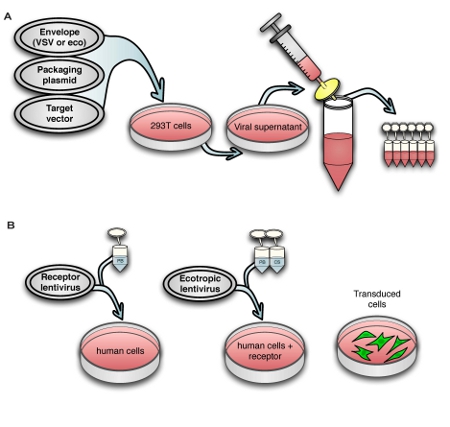
Figure 1. Schematic view of (A) the virus production process and (B) transduction of human cells with murine retrovirus receptor followed by ecotropic lentivirus.
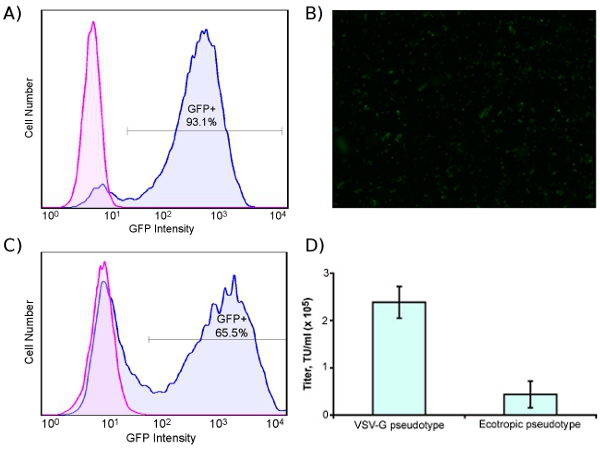
Figure 2. High-efficiency transduction of human cells with ecotropic lentivirus encoding GFP. Cells were pre-transduced with murine retrovirus receptor Slc7a1. (A) Human rhabdomyosarcoma cell line blasticidin-selected for Slc7a1 (Slc-hRMS), transduced (blue) or untransduced (pink) with GFP. (B) Fluorescent micrograph of ecotropic-transduced Slc-hRMS (4X). (C) HDFs transduced (blue) and untransduced (pink) with ecotropic GFP lentivirus; cells were transduced with Slc7a1 two days prior to ecotropic transduction. (D) Titer of VSV-G pseudotyped and ecotropic lentivirus, measured on Slc-hRMS.
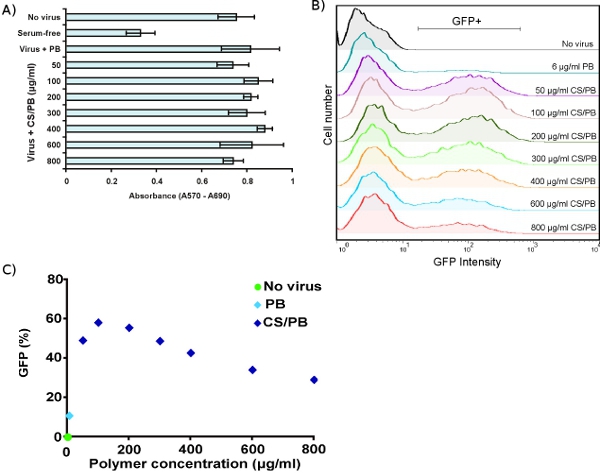
Figure 3. Optimizing chondroitin sulfate/polybrene (CS/PB) concentrations in human dermal fibroblasts. (A) Viability of HDFs measured by MTT assay after transduction in the presence of PB only or with varied concentrations of CS/PB. (B) Enhancement of transduction efficiency in HDFs by different concentrations of CS/PB, measured by FACS. (C) Quantification of transduction enhancement, showing that maximum transduction occurs at 100 μg/ml CS/PB.
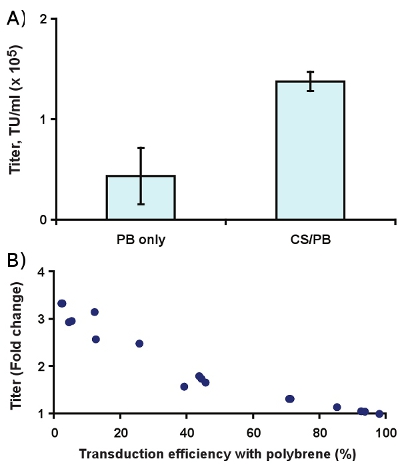
Figure 4. Effect of 400 μg/ml CS/PB on transduction of Slc-hRMS with ecotropic lentivirus. (A) Titer enhancement, and (B) fold change in transduction rate compared to 6 μg/ml polybrene alone.
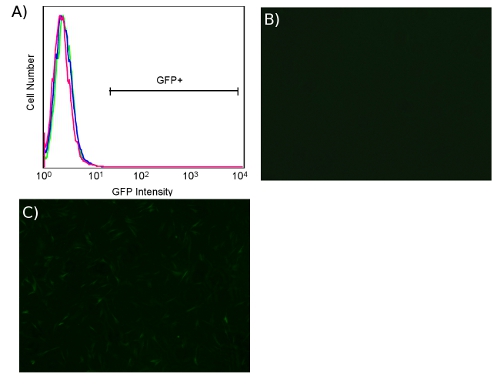
Figure 5. Lack of ecotropic transduction of HDFs in the absence of murine retrovirus receptor Slc7a1. (A) FACS plot of BJ human fibroblasts, untransduced (pink) or transduced (blue) with ecotropic GFP lentivirus in both cases in the absence of receptor Slc7a1. BJ human fibroblasts transduced with ecotropic GFP lentivirus, without (B) and with (C) pre-transduction with receptor Slc7a1 (4X).
토론
몰로니 murine의 백혈병 바이러스 (MLV)과 그 수용체 mSlc7a1에 따라 재조합 ecotropic gammaretrovirus 잘 연구하고 널리 없습니다 murine 세포 transgenes를 제공하기 위해 20여 년 동안 사용되고 보내고있다. Ecotropic gammaretrovirus도 인간의 세포 oncogenes를 제공하기 위해 최근 사용되고 있습니다,. 셀룰러 프로그래밍의 맥락에서, mSlc7a1의 사용은 잘 설립 인간 oncogenes을 품고 amphotropic 바이러스의 생성을 피하기 위해 4,5 단, lentivirus은 gammaretrovirus에 비해 상당한 장점을 제공합니다 lentiviral 사전 통합 복잡한 허용하기 때문에 내화물 세포 집단, 종종 프로그래밍을 위해 바람직 목표물 6를 포함한 기본 세포를 transducing가 아닌 나누어 세포의 형질 도입 7.
Lentiviruses는 바이러스 tropism, 독성, 및 기타 특성 8. MLV - pseudotyped ecotropic의 lentivirus은 마우스 세포, 9 transduce하는 데 사용되었지만 거의 인간의 세포에 사용되지 않은 내용을 변경하기 위해 MLV를 포함한 다양한 pseudotypes 수십, 함께 제작되었습니다 10. 우리는 따라서 인간의 세포에 세포 프로그래밍 요소를 포함하여 알려지거나 의심 oncogenes을, 제공하는 안전하고 비용 효율적인, 그리고 고효율 차량으로 MLV - pseudotyped ecotropic lentivirus의 사용을 제안합니다.
오히려,이 프로토콜은 암 관련 바이러스 자체 접종 잠재력에서 연구자를 단열, pantropic 바이러스에서 oncogene (들)을 분리, 그것은이 프로토콜은 완전히 pantropic lentivirus을 생산하고 사용할 필요성을 제거하지 않습니다에 중요합니다. 단백질 mSlc7a1과 인간 homologue의 hSlc7a1는 ubiquitously 알려진 tumorigenicity 또는받는 사람 세포에 선택 성장 우위를 부여하는 능력, amphotropic 바이러스에 설립에 대한 상대적으로 낮은 위험이 11 만들기 mSlc7a1 아니요 아미노산 운반을 표명하고 있습니다. 이것은 추가 단계 필요 biosafety 수준의 전용 바이러 스나 조직 문화 시설 부족 실험실에서 특히 유용할 수 있습니다.
어떤 상황에서는 완전히 대상 세포에 직접 Slc7a1이 플라스미드 transfecting에 의해 pantropic 바이러스의 사용을 제거하는 것이 가능 수 있지만,이 기술의 유용 대상 될 많은 세포는 transfection에 내화물 있습니다. 대안으로 분리할 수있는 능력 blasticidin 선택하여 세포를 Slc7a1는 - transduced 것은 VSV - G pseudotyped lentivirus가 ecotropic 바이러스가 많은 이들 세포를 transduce하기 위해 일상적으로 사용할 수있는 이후 수용체 - 표현 세포의 주식을 생성 한 번 사용될 수있다는 것을 의미 실험. 연구원에 관계없이 항상 그 tropism의 모든 lentivirus 작업을 위해 제도적 안전 지침을 따라야합니다.
이 프로토콜과 함께 실현 ecotropic 바이러스 Titers 이전 연구와 합의에 일반적으로 VSV - pseudotyped 바이러스, pantropic 바이러스 titer의 10~20%보다 적당히 낮은 9. 이러한 titers가 안정 Slc7a1와 transduced 인간의 세포로 측정되었다, 그래서 낮은 ecotropic 바이러스에 대한 관찰 titer는 대상 세포에있는 수용체 유전자의 다양한 표현에 일부가 원인일 수 있습니다. 그럼에도 불구하고, 우리 프로토콜 획득 바이러스 titers은 대부분의 어플 리케이션을위한 충분한보다되며 어떤 경우에는 세포의 과반수의 도입으로 이어질> 세포의 90 %.
원심 분리 기반 기술은 일반적으로 바이러스 입자를 집중하는 데 사용됩니다. 그러나, 원심 분리는 몇 시간을 필요로 전염성 에어로졸을 생성하고, 바이러스 입자의 상당한 손실이 발생할 수 있습니다. 12 대안, CS / PB와 함께 complexation으로이 바이러스 tropism를 변경하지 않고 전달을 향상시키는 데 사용할 수 있습니다. 3이 방법은 (5 분 빠른있다 대략 관찰된 titer를 tripling 동안 (10 ML 바이러스 당 $ 0.03)) 저렴. 특별한 장비 또는 독점적인 시약이 필요하지 않으며 다른 세포 라인의 이전 작업과 동의, CS / PB에 HDFs의 노출 후 최소한의 급성 독성을 관찰하고 있습니다.이 프로토콜 13 한 잠재적인 단점이 몇 가지 미세 표시 폴리머 단지가 고수이다 문화에 몇 일 동안 세포. 우리는이 단지는 세포에 독성 명백히 없지만, 세포 프로세스에 대한 자세한 미묘한 영향을 수있는 가능성을 배제할 수 없습니다.
여기 우리는 안전하고 효과적으로 종양 발생 요인과 인간의 세포를 transducing위한 방법론을 설명합니다. 이러한 접근 방식은 IPS 세포를 포함한 oncogenes 및 줄기 세포 생물학을 공부하면서 연구에 큰 유틸리티의해야합니다.
공개
감사의 말
이 프로젝트에 대한 자금은 재생 의료에 대한 캘리포니아 연구소에 의해 제공되었다.
자료
| Name | Company | Catalog Number | Comments |
| 시약의 이름 | 회사 | 카탈로그 번호 | 댓글 |
|---|---|---|---|
| pLenti6/UbC/mSlc7a1 | Addgene | 17,224 | Murine MLV 수용체 |
| pMD2.G | Addgene | 12,259 | VSV - G 봉투 |
| pCMV - dR8.91 | D. Trono 연구소 14 | 포장 플라스미드 (이에 상응하는 플라스미드 psPax2가 Addgene에서 구할 수 고양이. 넘버 12260) | |
| pHCMV - EcoEnv | Addgene | 15,802 | Ecotropic 봉투 |
| FUGW | Addgene | 14,883 | 플라스미드 GFP 제어 |
| OptiMEM | Invitrogen | 31,985 | |
| Fugene HD | 로체 | 04 709 705 001 | |
| Hexadimethrine 브로마이드 (Polybrene) | 시그마 - 알드리치 | H9268 | |
| 상어 연골의 콘드로이틴 황산 나트륨 소금 | 시그마 - 알드리치 | C4384 | |
| Blasticidin S | 어부 | BP 2,647,100 | |
| Methylthiazolyldiphenyl - tetrazolium 브로마이드 (MTT) | 시그마 - 알드리치 | M2128 | |
| Igepal CA - 630 | 시그마 - 알드리치 | I3021 |
참고문헌
- Davis, H. E., Rosinski, M., Morgan, J. R., Yarmush, M. L. Charged polymers modulate retrovirus transduction via membrane charge neutralization and virus aggregation. Biophys J. 86, 1234-1242 (2004).
- Marino, M. P., Luce, M. J., Reiser, J. Small- to large-scale production of lentivirus vectors. Methods Mol Biol. 229, 43-55 (2003).
- Landazuri, N., LeDoux, J. M. Complexation of retroviruses with charged polymers enhances gene transfer by increasing the rate that viruses are delivered to cells. J Gene Med. 6, 1304-1319 (2004).
- Ohnuki, M., Takahashi, K., Yamanaka, S. Generation and characterization of human induced pluripotent stem cells. Curr Protoc Stem Cell Biol. 4, 4A.2-4A.2 (2009).
- Hotta, A. EOS lentiviral vector selection system for human induced pluripotent stem cells. Nat Protoc. 4, 1828-1844 (2009).
- Reiser, J. Transduction of nondividing cells using pseudotyped defective high-titer HIV type 1 particles. Proc Natl Acad Sci U S A. 93, 15266-15271 (1996).
- Cullen, B. R. Journey to the center of the cell. Cell. 105, 697-700 (2001).
- Cronin, J., Zhang, X. Y., Reiser, J. Altering the tropism of lentiviral vectors through pseudotyping. Curr Gene Ther. 5, 387-398 (2005).
- Schambach, A. Lentiviral vectors pseudotyped with murine ecotropic envelope: increased biosafety and convenience in preclinical research. Exp Hematol. 34, 588-592 (2006).
- Koch, P., Siemen, H., Biegler, A., Itskovitz-Eldor, J., Brustle, O. Transduction of human embryonic stem cells by ecotropic retroviral vectors. Nucleic Acids Res. 34, e120-e120 (2006).
- Yoshimoto, T., Yoshimoto, E., Meruelo, D. Molecular cloning and characterization of a novel human gene homologous to the murine ecotropic retroviral receptor. Virology. 185, 10-17 (1991).
- Cepko, C. Large-scale preparation and concentration of retrovirus stocks. Curr Protoc Mol Biol. Chapter 9, Unit 9.12-Unit 9.12 (2001).
- Doux, J. M. L. e., Landazuri, N., Yarmush, M. L., Morgan, J. R. Complexation of retrovirus with cationic and anionic polymers increases the efficiency of gene transfer. Hum Gene Ther. 12, 1611-1621 (2001).
- Zufferey, R. Self-inactivating lentivirus vector for safe and efficient in vivo gene delivery. J Virol. 72, 9873-9880 (1998).
재인쇄 및 허가
JoVE'article의 텍스트 или 그림을 다시 사용하시려면 허가 살펴보기
허가 살펴보기This article has been published
Video Coming Soon
Copyright © 2025 MyJoVE Corporation. 판권 소유